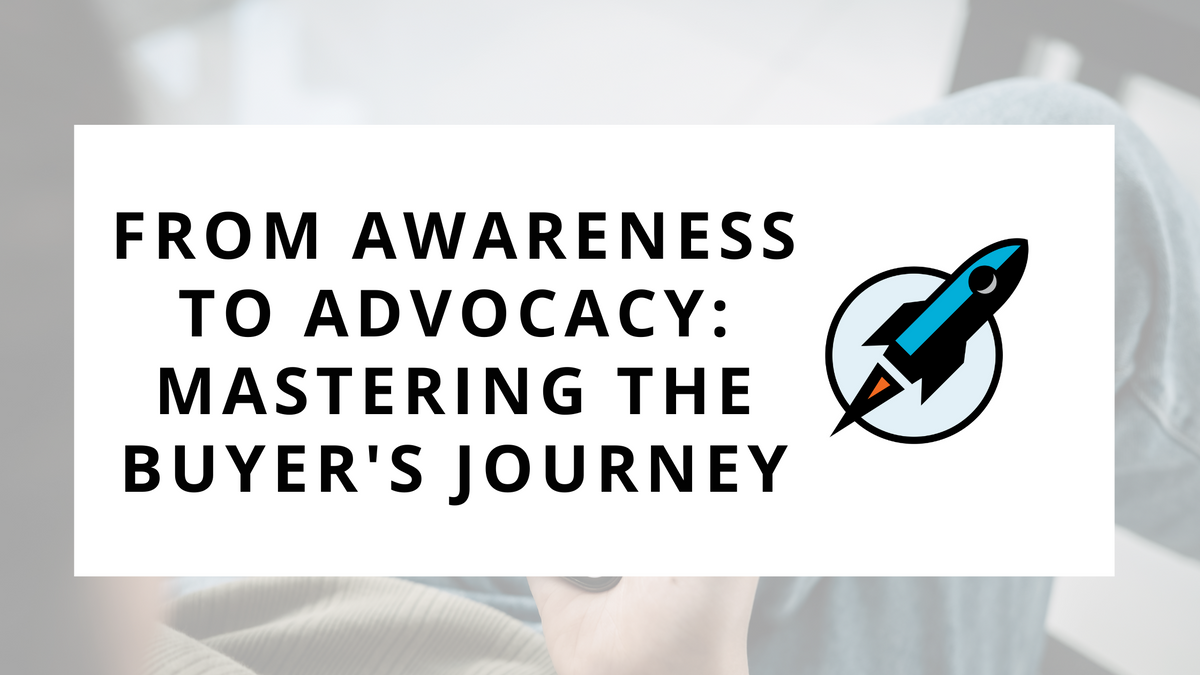From Awareness to Advocacy: Mastering the Buyer's Journey

Do your customers wake up one day ready to buy your product?
Of course not!
Every buyer goes through a journey that leads them to a final purchase. This is true of nearly every purchase, from cheeseburgers, to automobiles, to computer software.
We call this process "The Buyer's Journey." And it's a key concept to understand when creating a digital sales strategy.
What is the Buyer's Journey?
The buyer's journey refers to the steps a customer goes through to make a purchase decision. It typically consists of the following stages:
- Problem Awareness – The buyer becomes aware that they have a problem that needs to be solved.
- Solution Research – The buyer researches potential ways to solve the problem.
- Decision Making – The buyer makes the financial decision of which product or service to purchase.
- Post-Purchase – The buyer evaluates their purchase and implements the solution.
The buyer's journey is path dependent, with one stage leading the next. And while there may be some cases where buyers skip stages, our bounces around, they generally follow something similar to this standard buyer's journey.

Let's explore each of those stages in more detail and use the purchase of a cheeseburger as an example.
Problem Awareness
This is the first stage when your prospects discover they have a problem or an opportunity to address. This is where they go from unawareness to awareness.
In problem awareness, your buyers start to ask a lot of "why" questions:
- Why is this not working?
- Why is this process important?
- Why am I feeling this way?
- Why am I not getting the results I want?
If we were buying a cheeseburger, this is the stage where we start to feel hungry. We feel a rumbling in our stomach and become aware that it might be time to eat. We check the clock, and it's 11:45, lunchtime!
Solution Research
Once the buyer understands they have a problem, the next stage is where they try to understand the approaches, methods, or products that can best help them solve their problems. This is the solution research phase.
In this stage, the buyer starts to ask questions of "how" and "what" will be used to address their problem:
- What tools are available?
- What are industry best practices?
- What are the options for implementing?
- How should this be fixed/implemented?
In our cheeseburger example, this stage is where we think about what we can eat. Would a protein bar be enough? Do we have food in the fridge? Should I drive to a restaurant? What restaurants are nearby? If we realize we need a full meal and don't have food in the fridge, then we determine a restaurant is our best option.
Decision Making
Now that buyer knows what solution they want; it's time for them to make a decision. In this stage, the buyer will create a shortlist of final purchase options and pick a vendor to buy from.
In this stage, the buyer asks "who" they should work with. They start asking questions like:
- Who has the best options?
- Who has a price that will get me an ROI?
- Who has proof of success?
- Who can I trust?
In our cheeseburger example, this is where we decide which restaurant we want to go to. We narrow down that we want something quick, inexpensive, and filling… A cheeseburger? We go through the drive-through at our local burger joint, confirm what we want on the menu, and order a double cheeseburger.
Post-Purchase
And the final stage of the buyer's journey is post-purchase, where your buyer evaluates the purchase and continues your relationship. This stage is often overlooked, but it's a critical part of the lifetime value of an account and the ability to generate referrals.
In this stage, the buyer asks questions regarding their experience of the purchase, such as:
- Did I make the change successfully?
- How do I maintain the change?
- How can I get trained to use the solution better?
- When will I need to purchase it again?
Returning to our cheeseburger example, the post-purchase stage is where we contemplate our meal. Did it satisfy our hunger? Did it taste good? Do we recommend our friends eat there? Will we buy from there again?
10 Ways to Leverage The Buyer's Journey
Step-by-step, the buyer's journey provides a path that our customers navigate as they move through their purchase. We can better strategize our sales and marketing activities by understanding these steps.
Understanding where potential customers are in their buying process enables salespeople to tailor their approach, provide relevant information, and build stronger relationships.
Here are some ways sales reps can use the buyer's journey to improve their sales strategy:
- Identify and Qualify Prospects: By recognizing the stage of the buyer's journey a prospect is in, sales reps can determine their level of interest and commitment. This helps prioritize leads and focus on prospects who are more likely to convert.
- Personalized Communication: Sales reps can adapt their messaging and content to address each buyer's specific needs and pain points at different stages of the journey. Personalization builds rapport and demonstrates empathy, which fosters trust and credibility.
- Offer Relevant Information: Provide valuable resources, such as case studies, product guides, or comparison sheets, that align with the buyer's current stage. This helps customers make informed decisions and reinforces the sales rep's role as a helpful advisor.
- Engage at the Right Time: Timing is crucial in sales. By understanding where the prospect is in their journey, sales reps can engage with them at the appropriate moment, avoiding premature pitches or missing out on critical touchpoints.
- Address Objections and Concerns: Different stages of the buyer's journey come with unique concerns and objections. Sales reps can anticipate and address these issues proactively, smoothing the path to purchase and increasing the chances of closing the deal.
- Tailor the Sales Pitch: As prospects progress through the buyer's journey, their priorities may shift. Sales reps can modify their sales pitch to highlight the product or service's most relevant features and benefits based on the buyer's current stage.
- Focus on Relationship-Building: The buyer's journey isn't just about making a sale; it's about building lasting relationships. Sales reps who understand this can foster trust and loyalty, leading to repeat business and positive word-of-mouth referrals.
- Collaborate with Marketing: Work closely with the marketing team to align sales strategies with marketing efforts. Marketing can provide valuable insights into the buyer's journey through data analytics and customer research.
- Utilize CRM and Sales Tools: Sales reps can leverage Customer Relationship Management (CRM) software and sales tools to track and manage prospects at various stages of the buyer's journey. This streamlines the sales process and ensures no opportunities slip through the cracks.
- Measure and Adapt: Continuously analyze the effectiveness of the sales strategy by tracking key performance indicators (KPIs) and soliciting feedback from prospects and customers. Use this information to refine and improve the sales approach over time.
By integrating the buyer's journey into their sales strategy, you can position yourself as a trusted advisor, provide value, and increase their chances of success in closing deals.

This week's action items are about finding ways to leverage the buyer's journey in your sales process.
Here's what you need to do:
- Map Out The Buyer's Journey – Use the framework of stages above, or modify as appropriate, to map out the buyer's journey for your business. Brainstorm about how your ideal customers go from problem awareness to happy customers.
- Review Existing Deals – Get your team together and review recent deals in the context of your journey framework. How did that example customer move the framework? What questions did they ask at each stage? What caused them to convert to the next stage? What content did they interact with?
- Plan Your Strategy – Now consider how you can further strengthen your buyer's journey. What content can you create at each stage to help sales? Use a tool like a content matrix to plan your strategy. Put yourself in your customer's shoes to look for ways to improve the buying process throughout the entire buyer's journey.
